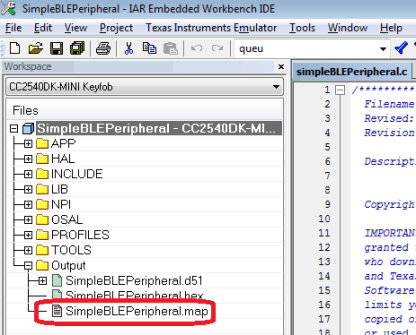SWRU271I October 2010 – January 2020 CC2540 , CC2540T , CC2541 , CC2541-Q1 , CC2640R2F
- Preface
- 1Overview
- 2The TI Bluetooth Low Energy Software Development Platform
- 3The Operating System Abstraction Layer (OSAL)
- 4The Application and Profiles
-
5The Bluetooth Low Energy Protocol Stack
- 5.1 Overview
- 5.2 Generic Access Profile (GAP)
- 5.3 GAPRole Task
- 5.4 Gap Bond Manager (GAPBondMgr)
- 5.5
Generic Attribute Profile (GATT)
- 5.5.1 GATT Characteristics and Attributes
- 5.5.2 GATT Services and Profile
- 5.5.3 GATT Client Abstraction
- 5.5.4 GATT Server Abstraction
- 5.6 L2CAP
- 5.7 HCI
- 5.8 Library Files
- 6Drivers
- 7Creating a Custom Bluetooth Low Energy Application
- 8Development and Debugging
-
9General Information
- 9.1 Overview
- 9.2 Porting From BLE-Stack 1.5.0 to 1.5.1
- 9.3 Porting From BLE-Stack 1.4.2 to 1.5.0
- 9.4
Porting From Earlier BLE-Stack Versions
- 9.4.1 Porting BLEv1.4.1 Projects to BLEv1.4.2
- 9.4.2 Porting BLEv1.4.0 Projects to BLEv1.4.1
- 9.4.3 Porting BLEv1.3.2 Projects to BLEv1.4.0
- 9.4.4 Porting BLEv1.2 Projects to BLEv1.3
- 9.4.5 Porting From CC2540 to CC2541 Project
- 9.5 Release Notes History
- 9.6 Document History
- A GAP API
- B GAPRole Peripheral Role API
- C GAPRole Central Role API
- D GATT/ATT API
- E GATTServApp API
- F GAPBondMgr API
- G HCI Extension API
- Revision History
8.3.4 Linker Map File
After building a project, IAR generates a linker map file that you can find in the Output group in the file list.
 Figure 8-11 Map File in File List
Figure 8-11 Map File in File List The map file contains low-level information about the build. Lines of text similar to the following are at the end of the map file:
118 544 bytes of CODE memory
35 bytes of DATA memory (+ 73 absolute )
6 242 bytes of XDATA memory
194 bytes of IDATA memory
8 bits of BIT memory
4 149 bytes of CONST memory
Errors: none
Warnings: none
This text shows the total code space (CODE memory) and RAM (XDATA memory) the project uses. Ensure the sum of the CODE memory plus CONST memory does not exceed the maximum flash size of the device (either 128KB or 256KB, depending on the version of the CC2540/41). Ensure the size of the XDATA memory does not exceed 7936 bytes, as the CC2540/41 contains 8KB of SRAM (256 bytes are reserved).
For more specific information, the map file contains a section called MODULE SUMMARY. This section is approximately 200 to 300 lines before the end of the file (the exact location varies from build-to-build). Within this section, you can see the exact amount of flash and memory for every module in the project.